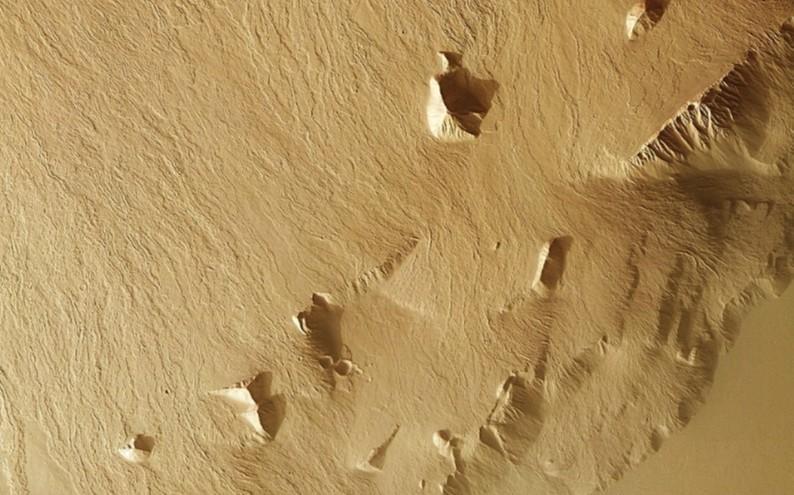
Pics of Mars’ Volcano Reveal Details of Frozen Lava Rivers
The European Space Agency (ESA) has recently shared breathtaking images of Olympus Mons, the largest volcano in our solar system, located on the planet Mars. The stunning photos provide a glimpse into the planet’s volcanic past, revealing frozen rivers of lava that once flowed down the slopes of this massive wonder. Olympus Mons is a marvel of geological formation, standing at an impressive 27 km high and boasting a base that spans over 600 km in width.
The ESA’s images offer a unique perspective on the volcano’s structure, showcasing the intricate details of its surface. The frozen lava rivers, which were once molten and flowing, are now a testament to the planet’s volcanic history. These rivers, which were formed as a result of ancient eruptions, have been preserved in time, providing scientists with valuable insights into the geological processes that shaped the Martian surface.
Olympus Mons is considered a dormant volcano, with no recent eruptions recorded. It is estimated to have formed around 3.5 billion years ago, during a period of intense volcanic activity on Mars. The volcano’s massive size and gentle slopes are a result of the slow and continuous eruption of lava flows over millions of years. The lava flows, which were rich in iron and magnesium, accumulated and solidified, forming the volcano’s distinctive shield-like shape.
The frozen lava rivers that crisscross the surface of Olympus Mons are a fascinating feature of the volcano. These rivers, which were once flowing with molten lava, have been frozen in time, preserving the delicate patterns and textures of the lava flows. The ESA’s images reveal the intricate details of these rivers, showcasing the complex networks of channels and tubes that once carried the molten lava down the slopes of the volcano.
The study of Olympus Mons and its frozen lava rivers provides scientists with a unique opportunity to gain insights into the geological history of Mars. By analyzing the volcano’s structure and the patterns of the lava flows, researchers can reconstruct the planet’s volcanic past and better understand the processes that shaped the Martian surface. The ESA’s images of Olympus Mons are a valuable addition to our understanding of the planet’s geology, offering a glimpse into a period of intense volcanic activity that shaped the Martian landscape.
The ESA’s images of Olympus Mons are not only significant for their scientific value but also for their aesthetic appeal. The stunning photos, which were captured by the agency’s Mars Express orbiter, offer a breathtaking view of the Martian surface. The images, which are available on the ESA’s website, provide a unique perspective on the planet’s geology, showcasing the intricate details of the volcano’s surface.
In addition to the scientific significance of the images, the ESA’s photos of Olympus Mons also highlight the importance of space exploration. The study of Mars and its geological features provides valuable insights into the formation and evolution of our solar system. By exploring the Martian surface and studying its geological features, scientists can gain a better understanding of the processes that shaped our planet and the potential for life beyond Earth.
In conclusion, the ESA’s images of Olympus Mons are a remarkable achievement, offering a glimpse into the planet’s volcanic past and providing valuable insights into the geological processes that shaped the Martian surface. The frozen lava rivers that crisscross the surface of the volcano are a fascinating feature, preserving the delicate patterns and textures of the lava flows. As we continue to explore the Martian surface and study its geological features, we may uncover even more secrets about the planet’s history and the potential for life beyond Earth.
The study of Mars and its geological features is an ongoing process, with new discoveries and insights being made regularly. The ESA’s images of Olympus Mons are a significant addition to our understanding of the planet’s geology, and they will undoubtedly play an important role in shaping our knowledge of the Martian surface. As we look to the future and continue to explore the solar system, the study of Mars and its geological features will remain a vital part of our quest for knowledge and understanding.
For more information and to view the stunning images of Olympus Mons, visit the news source: https://www.instagram.com/p/DRCvJIKjNiX/
News Source: https://www.instagram.com/p/DRCvJIKjNiX/




